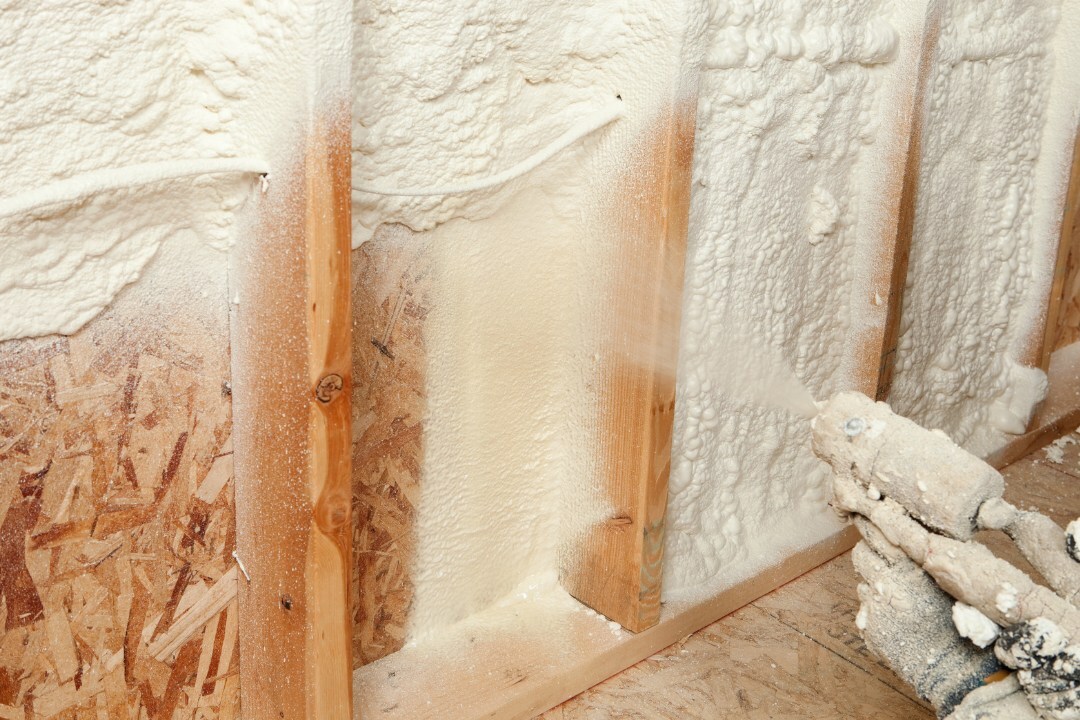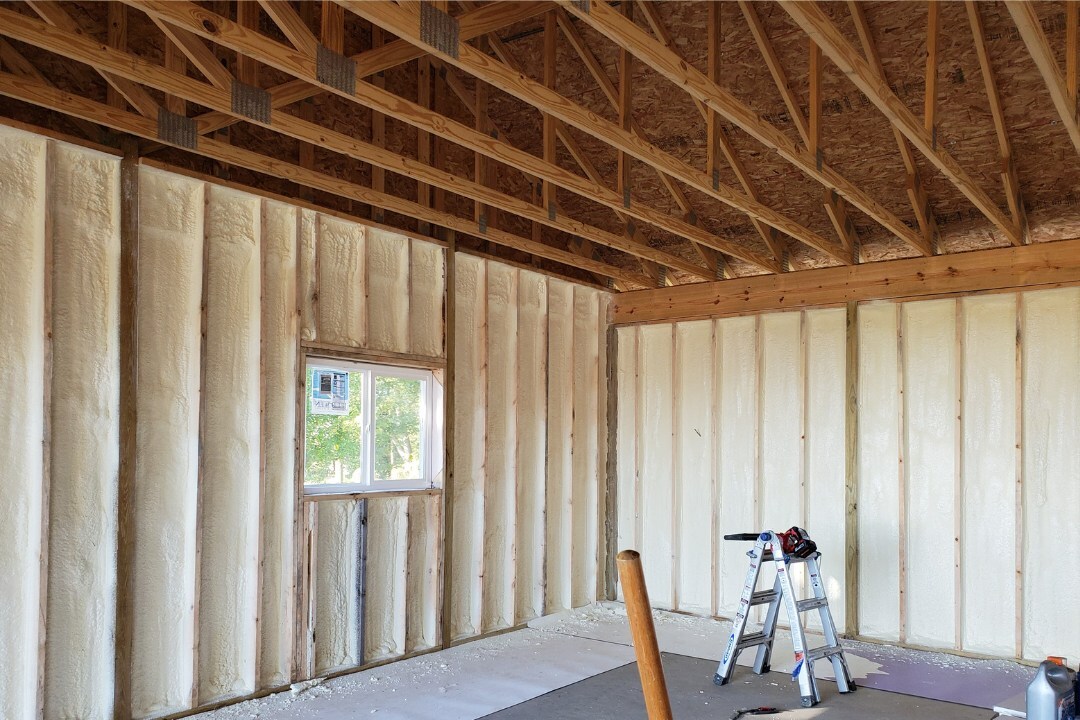Expansion foam is a spray-applied material that expands as it cures, filling gaps, cracks, and cavities to create a solid, airtight, and often fire-resistant seal. It’s commonly made from polyurethane and used for everything from home insulation to industrial fire suppression.
At its core, expansion foam is designed to control air movement, moisture, and temperature. There are two main categories: high expansion foam and low expansion foam. Each behaves differently once applied, affecting how much it expands, how dense it becomes, and what types of projects it’s best suited for.

Understanding these differences helps determine which foam is the right choice for your application, whether you’re sealing window frames, insulating a warehouse, or managing fire safety in large structures.
- Low expansion foam expands 20-30 times its liquid size and is suitable for quickly filling cracks and small openings (e.g., space along the floor and wall intersection); plumbing, HVAC and electrical penetrations (e.g., gap between the hole and pipe); and large spaces such as unfinished walls, ceilings and floors in the basement, attic and crawl spaces.
- High expansion foam, in comparison, expands 200-300 times its liquid size and is more appropriate for use in larger, commercial or industrial spaces. In other words, if you’ve never used expanding foam before, get the low expansion variety. Otherwise, you’ll have the daunting task of cleaning big messy globs of uncured foam off your walls, floors and skin. (Tip: Adding more expansion foam is easy, but removing it is difficult.)
It’s important to note here the terms “low expansion foam” and “high expansion foam” should not be confused with the terms “low density” or “high density” foam. Density refers to the number of pounds per cubic foot a foam weighs once it’s cured. For example, when an expansion foam product is said to have the density of “two pounds,” that means the foam has a density of “two pounds per cubic feet.” Furthermore, low and high expansion foam can have low, medium or high density.
Understanding Expansion Ratios
Expansion ratio is what separates high expansion foam from low expansion foam. It describes how much the foam grows compared to its original liquid volume once it’s released and begins curing.
High expansion foams can expand anywhere from 20:1 to 1000:1, meaning one unit of liquid can become hundreds or even thousands of times larger. Low expansion foams, on the other hand, typically expand up to 10:1, giving you more control during application.
This difference matters because expansion ratio directly affects how dense the foam is, how much space it fills, and how it behaves once cured. A higher ratio covers more area but is lighter and less dense, while a lower ratio creates a denser, more rigid seal that’s ideal for smaller or precision-based applications.
More About High Expansion Foam
High expansion foam is designed to fill large spaces quickly by expanding far beyond its liquid volume. It produces a light, airy foam that forms a thick blanket capable of displacing smoke, heat, and oxygen during a fire. This makes it a vital tool in fire suppression systems for warehouses, aircraft hangars, mining tunnels, and other wide or confined industrial spaces.
Because of its high expansion ratio—often between 200:1 and 1000:1—it can cover massive areas with minimal liquid concentrate. The foam is typically air-filled and water-based, which means it’s lightweight, easy to deploy, and can rapidly smother Class A and Class B fires.
Beyond firefighting, high expansion foam can also be used for temporary sealing, vapor suppression, and training simulations. Its ability to create large volumes of foam in seconds makes it a cost-effective solution for large-scale safety and containment operations.

More About Low Expansion Foam
Low expansion foam expands up to about ten times its liquid volume, giving it much more control and density compared to high expansion foam. It’s often made from closed-cell polyurethane, which creates a tough, moisture-resistant barrier once cured.
This type of foam is commonly used in residential and commercial insulation, sealing windows and doors, and filling smaller gaps where precision is key. Because it expands slowly and predictably, it won’t warp frames or push apart materials during application.
Low expansion foam also provides excellent thermal insulation and air sealing properties, helping improve energy efficiency while preventing drafts and moisture buildup. Its dense structure makes it ideal for use in HVAC installations, soundproofing projects, and any application where strength and accuracy matter.
High Expansion Foam vs Low Expansion Foam: Key Differences
The main difference between high and low expansion foam comes down to how much they expand, how dense they become, and what they’re designed to do. High expansion foam is engineered for volume and coverage, while low expansion foam focuses on precision and control.
| Feature | High Expansion Foam | Low Expansion Foam |
|---|---|---|
| Expansion Ratio | 20:1 to 1000:1 | Up to 10:1 |
| Primary Use | Fire suppression, large spaces | Sealing, insulation, air barriers |
| Density | Light and airy | Dense and rigid |
| Application Control | Harder to control, covers large areas | Easier to direct in small gaps |
| Cost Efficiency | More efficient for large-scale use | Better for targeted applications |
| Common Locations | Warehouses, hangars, tunnels | Homes, offices, HVAC systems |
High expansion foam performs best where wide coverage is needed, such as displacing air during fires or sealing large voids. Low expansion foam excels in detailed work like insulating around windows, doors, or pipes, where overexpansion could cause damage. Each has its place depending on the project’s scale, safety needs, and precision requirements.
Expansion Foam & Curing Agents
How much expansion foam expands also depends on its curing agent -- meaning, does it come as a one-component, no curing agent formula; or two-component, “A” and “B” (curing agent) formula?
- One-Part polyurethane and latex expansion foams (“can foams”), do not come with accelerant curing agents. Instead, the foam cures (as a single component) by reacting with humidity. As such, it takes about 45-60 minutes to complete its curing and expands only about 2-3 times its original dispensed size. This mild expansion actually makes the one-component expansion foam suitable for eliminating small cracks, seams and gaps, which may be too big for caulk but too small for two-component expansion foam.
- Two-Part polyurethane expansion foams aka two-component foams, in contrast, come as two separate components (agent “A” and curing agent “B”). As the agents are dispensed into the nozzle at application, agent “B” (curing agent) mixes with agent “A” to accelerate the curing time of the components down to 60-90 seconds. It is this fast chemical reaction that produces the higher expansion of two-component foam and what makes it suitable for filling large holes, nooks and crannies in walls, ceilings and floors.
Which One Should You Use?
Choosing between high and low expansion foam depends on the scope and purpose of your project. For large industrial or emergency applications, high expansion foam is the clear choice. It can quickly fill vast areas with minimal liquid, making it ideal for fire suppression systems and spaces where containing smoke or vapor is critical.
For home improvement or construction projects, low expansion foam is usually more practical. It’s denser, more manageable, and safer for use around doors, windows, and framing. Its predictable expansion helps avoid damage while providing a strong seal that blocks drafts, moisture, and noise.
In general, use high expansion foam for large-scale fire protection or industrial safety and low expansion foam for insulation, sealing, or detailed installation work. Matching the foam type to your environment ensures better performance, lower costs, and longer-lasting results.
Frequently Asked Questions About High vs Low Expansion Foam
The key difference is how much the foam expands once applied. High expansion foam can grow up to 1000 times its liquid volume, while low expansion foam expands up to 10 times. This affects density, control, and ideal use cases.
Yes. Low expansion foam is safe for indoor applications once cured. It’s perfect for sealing windows, doors, and small cavities where controlled expansion is important.
Yes. High expansion foam is commonly used in fire suppression systems for large facilities like warehouses and aircraft hangars because it quickly blankets flames and removes oxygen.
Uncured foam can release vapors that may irritate skin or lungs. Once cured, both high and low expansion foams are inert and safe for use in homes or commercial spaces.
Low expansion foam is best for insulation since it provides a dense, airtight seal. High expansion foam is more suited for industrial fire control or filling very large spaces.
